Iguazu Falls is one of the world’s most spectacular and impressive waterfalls, straddling the border between Argentina and Brazil in South America.
With more than 275 individual cascades, Iguazu is actually the biggest waterfall system in the world! The closest comparison is probably Niagara Falls in Canada and the United States, although Iguazu Falls is bigger than Niagara by most measurements.
This spectacular waterfall has been made into a national park in Argentina and Brazil, and both sides of the falls are well worth a visit since they offer different views! You can see the best highlights of Iguazu in a couple of days, although you could easily spend longer.
This travel guide will explain how to get to Iguazu Falls Argentina or Brazil side (with or without a tour), plus a map of Iguazu Falls and more info. Lastly, I’ll share some interesting facts about the waterfall itself!
Where Is Iguazu Falls?
Iguazu Falls is located on the border of Argentina and Brazil, in the continent of South America.
There are towns and airports on both sides of the border, with plenty of tourist friendly hotels and restaurants, and you can easily go back and forth between the two countries to see both sides of the waterfall.
The town on the Argentine side of the falls is called Puerto Iguazu, while the Brazil side is called Foz do Iguacu.

Iguazu Falls is in Argentina and Brazil
How To Get To Iguazu Falls Argentina & Brazil
The main way to get to Iguazu Falls is by flying there from one of the big cities in Argentina or Brazil.
For the Argentina side, you can fly from Buenos Aires to Puerto Iguazu (airport code: IGR), which takes less than 2 hours and it’s offered by multiple airlines, with pretty reasonable prices. There are two airports in Buenos Aires (AEP or EZE) and you can use either of them to fly here.
If you’re in Brazil, you can fly from Sao Paulo or Rio De Janeiro to Foz do Iguacu (code: IGU), which takes about 2 hours, more or less. These routes are also offered by multiple airlines with daily departures.
Shop Now: Argentina & Brazil flights at Skyscanner

A busy day at Iguazu Falls
Once you arrive in the town of Puerto Iguazu, you can get to the Argentina waterfall by bus, taxi, or tour. The bus is cheap, safe, and easy to use, with regular departures from the bus terminal in town to the waterfall, and back.
However, if you want something more personalized and convenient, then a taxi or private tour can be a good option. You can ask the driver to wait for you while you explore the waterfall, and then take you back to town afterwards.
The Brazil side of Iguazu Falls works much the same way. You can get to the Brazil waterfall by bus, taxi, or tour, and all of these options work well depending on your needs and how much time you have in your itinerary.

Iguazu Falls Brazil side
It’s also easy to cross the international border between Argentina and Brazil, and go back and forth by bus, taxi, or tour, seeing both sides of the Iguazu waterfall.
For example, I based myself on the Argentina side of Iguazu Falls, but I did a day trip to the Brazil side using the bus, and I also did a separate day trip to the Paraguay side with a taxi.
As a US citizen, I didn’t need any visa for Argentina, Brazil, or Paraguay, so it was very easy to do day trips between them, but remember to check the current visa requirements for your nationality in these countries to avoid any border hassles, and don’t forget to bring your passport!
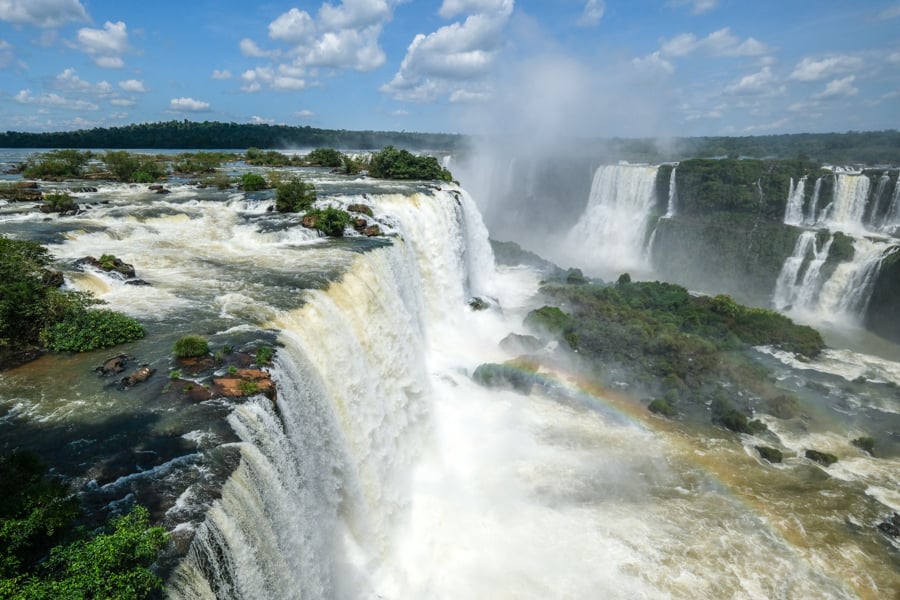
Views above the Iguazu waterfall
Best Iguazu Falls Tours
One of the easiest ways to visit Iguazu Falls is with a day tour from Puerto Iguazu or Foz do Iguacu.
GetYourGuide has high-rated day tours to see Iguazu Falls on the Argentina side, with optional boat tours where you can see the waterfalls up close and get soaked. This can be a fun way to see the beauty of Iguazu Falls from a different angle.
On the Brazil side, they have day tours to Iguazu Falls from Foz do Iguacu, with similar boat tours and an optional visit to the bird park. Just like on the Argentina side, these tours include a trilingual tour guide and hotel pickup and drop-off.
We’ve used GetYourGuide for lots of tours and activities around the world, and they’re great. Highly recommended!
Book Now: Iguazu Falls Argentina / Brazil Tour
Other Iguazu Falls Tours
GetYourGuide also has some convenient day tours that cross the border to see Argentina or Brazil from the other side. This can be a handy solution if you’re planning to see both sides of Iguazu Falls.
In other words, they have a tour that goes to the Argentina side of the falls starting from Brazil, or a tour to the Brazilian side starting from Argentina. Both of these are great.
If you’re short on time, they even have package tours from Buenos Aires or Rio De Janeiro that include flights, a private driver and tour guide, and your national park entrance tickets.
Iguazu Falls Argentina Side: What To Expect
Visiting Iguazu Falls is an amazing experience! The pictures don’t really do it justice at all.
The Argentina side of Iguazu Falls is bigger and more spread out than the Brazil side, so it’s divided into circuits that go to different parts of the waterfall. The very best things to see are the upper circuit, lower circuit, and Devil’s Throat viewpoint.
The park is well connected by walking trails and a free mini train system, so it’s pretty easy to get around. You can choose to walk the entire park, explore it by train, or use a combination of the two transport methods. There are also benches and cafes where you can stop and rest along the way.
If you’re in decent shape, I would recommend walking the upper and lower circuits in the morning without the train, and then using the train to go to the Devil’s Throat viewpoint in the afternoon. This will give you a good workout, but it’s not too much for a day.
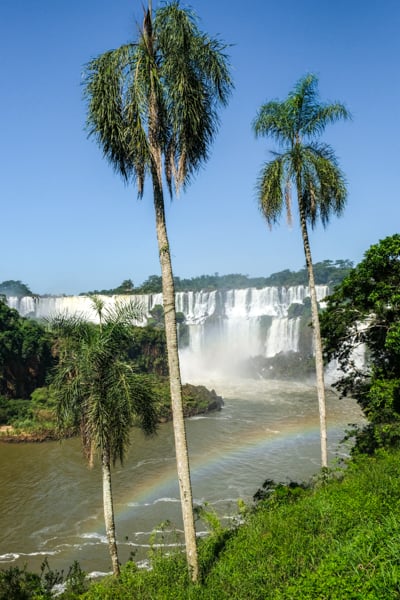
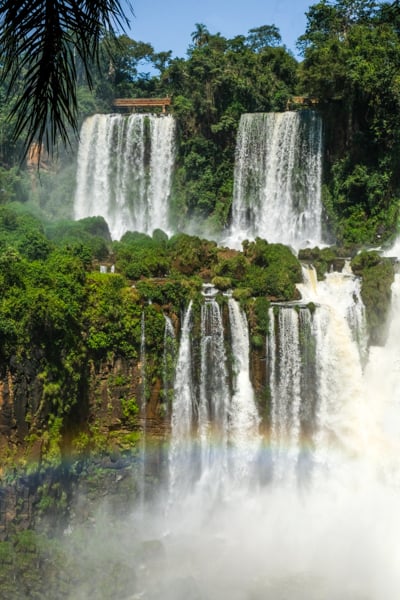
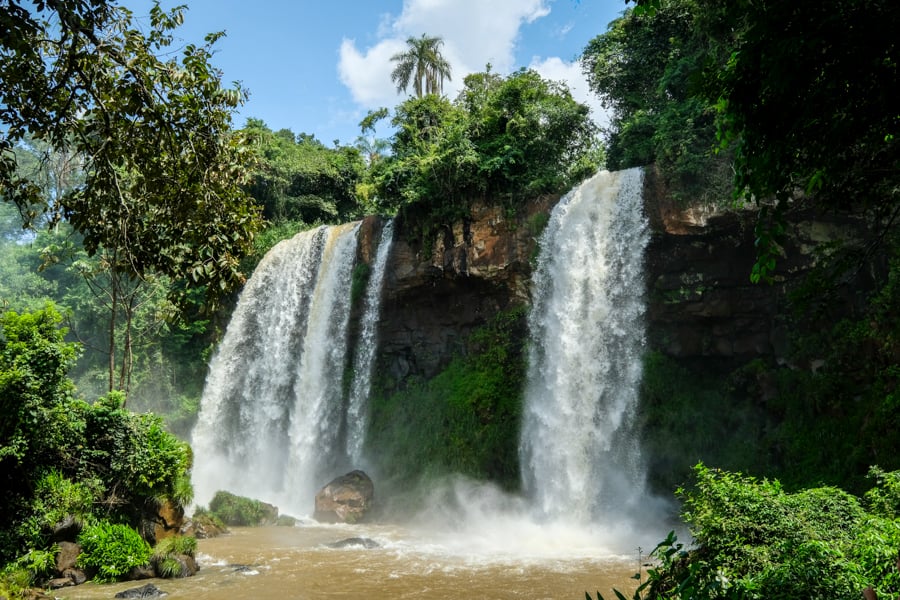
Twin waterfalls on the Argentina side
As you explore the national park, you can see all kinds of wildlife like monkeys, coatis, crocodiles, turtles, and lizards, plus various kinds of birds, spiders, and butterflies. If you’re lucky you might even see a tapir.
The upper and lower circuits at Iguazu both have some amazing panoramic views of the waterfall to enjoy, but in my opinion the very best thing to see in Argentina is the Devil’s Throat viewpoint (in Spanish: ‘Garganta Del Diablo’).
At the appropriately named Devil’s Throat, you can stand and gaze directly into the center of Iguazu Falls, which has a massive U-shaped curtain of water with a tremendous roaring sound and a cloud of mist.
I’d say this viewpoint is the single most impressive feature on either side of Iguazu Falls!
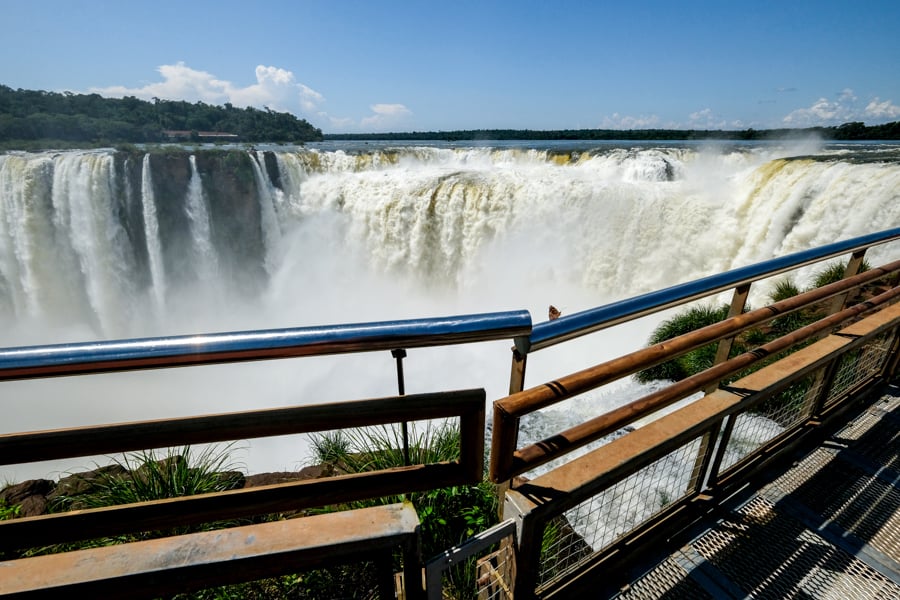
Devil’s Throat viewpoint (‘Garganta Del Diablo’)
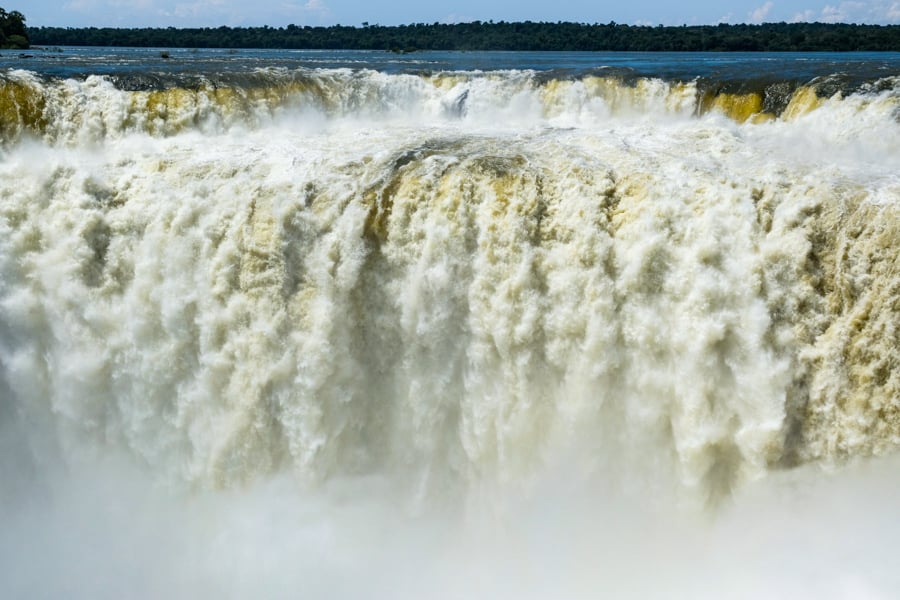
Massive wall of water
• Entrance Fee (Argentina)
Iguazu Falls is a national park in Argentina, so there’s a fee you have to pay to enter the park. This applies whether you’re visiting the walkways or doing other activities like a boat cruise, although some day tours may include the park fee in their price.
You can find the current entrance fee on the Argentina national parks website. However, if you visit two days in a row then the second day price is marked down by 50 percent, so just remember to keep your ticket so you can show them and get a discount.
You can pay for your park tickets with a credit or debit card, or with the local currency (Argentine Pesos). They also accept Brazilian Reals, US Dollars, or Paraguayan Guarani. I paid with a foreign credit card and that was fine.
You can book your park tickets in advance, but there’s really no need, because they’re unlimited and never sell out. Lines are always quick at the ticket counter, and I got my tickets in less than a minute. The only thing you might want to book in advance is the boat cruise.
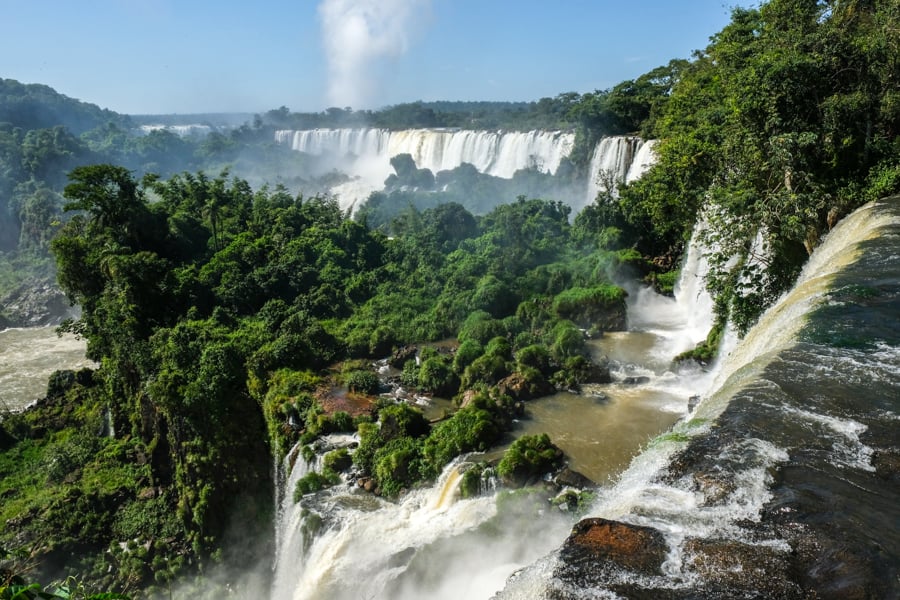
Iguazu Falls Argentina side
• Opening Hours (Argentina)
The opening hours for the Argentina side are 8 AM to 6 PM, but the last entry is at 4:30 PM.
This is the same every day of the year, including holidays like Christmas Day, New Year’s Day, and Easter Sunday.
• Map (Argentina)
Here’s a handy map of the Iguazu Falls Argentina side you can use to plan your trip. You can click the map to view it in full size.
There are also maps signposted throughout the national park to help you find your way to all of the trails and waterfalls.
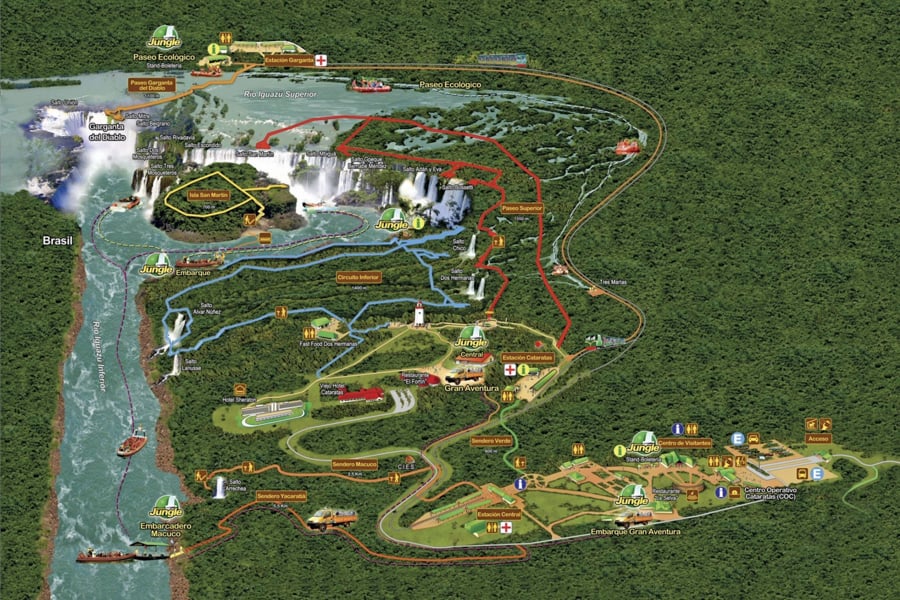
Map of Iguazu Falls Argentina side (© Parque Nacional Iguazu)
Iguazu Falls Brazil Side: What To Expect
The Brazil side of Iguazu Falls is a bit smaller and more simple than the Argentina side, but there’s still plenty of great things to see and do.
The park has one main pathway that follows the side of the river, ending with a thrilling balcony near the edge of the falls, and then several platforms that let you see the waterfall from above, either by going up stairs or taking an elevator.
The Brazil park is set up in a loop arrangement with a free bus service that takes you from the entrance gate to either end of the park, and back. Overall, it’s shorter and easier to visit than the Argentina side.
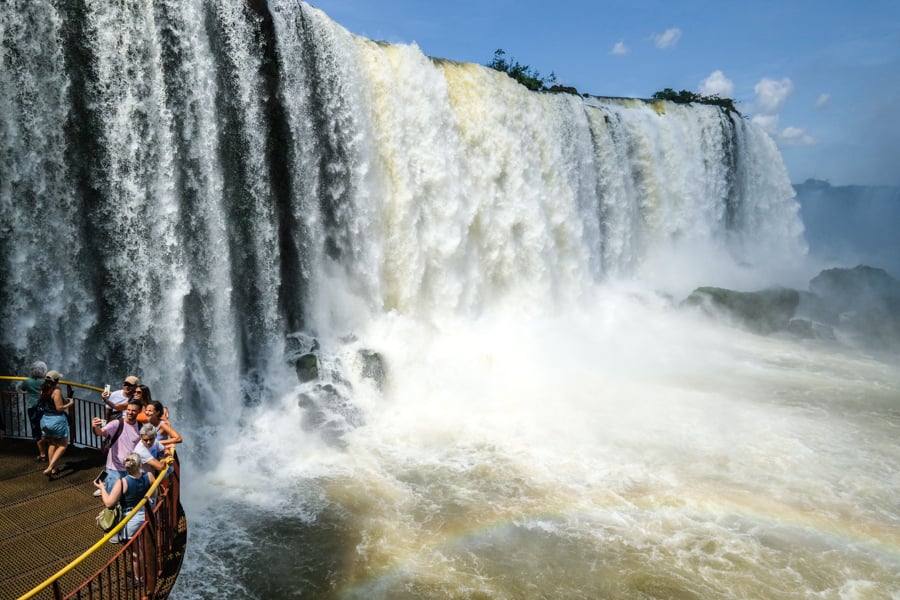
Getting up close with the waterfall
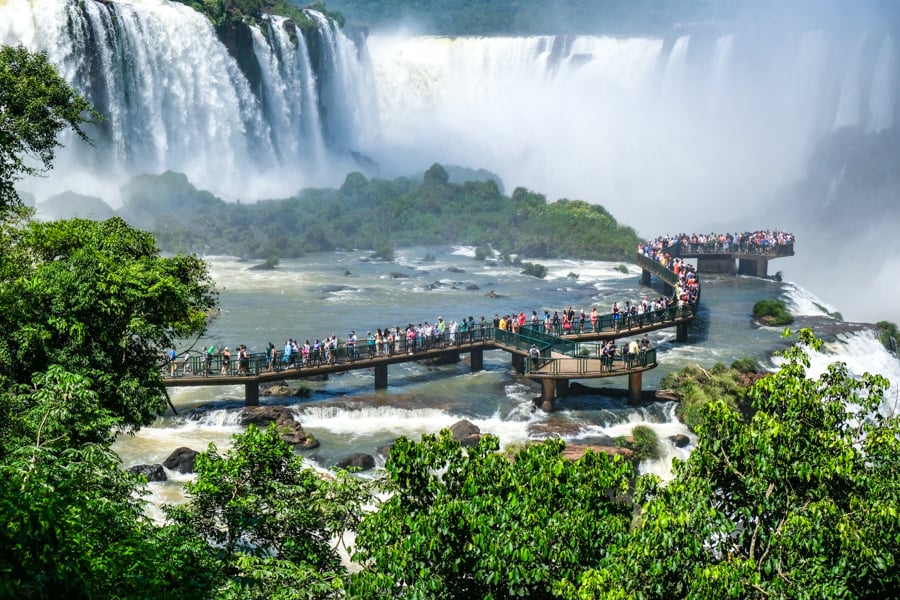
One of my favorite views on the Brazilian side of Iguazu Falls
I loved the Brazil side of Iguazu Falls, and even though it’s not quite as impressive as the ‘Devil’s Throat’ viewpoint in Argentina, I still think it’s more photogenic than the Argentina side in many ways. It would be a big mistake to skip this side of Iguazu just because it’s smaller!
When you get done exploring the Brazil side of Iguazu Falls, there’s also a nice bird park you can visit near the entrance to the national park. It has lots of great South American birds, including some colorful macaws and toucans!
The bird park is called ‘Parque Das Aves‘ and it’s just a short walk from the waterfall entrance. Don’t miss it! The ticket is separate from Iguazu, and it’s a little pricey, but it’s worth it.

An amazing toucan at the Brazil bird park
• Entrance Fee (Brazil)
You can check the current Brazil park fee on the official website here, and they also let you buy tickets in advance.
Just like on the Argentina side, there’s no need to book the park tickets in advance, because they’re unlimited and never sell out.
At the park entrance, you can pay for your tickets with a credit or debit card, or with the local currency (Brazilian Reals). They also accept Argentine Pesos, US Dollars, or Paraguayan Guarani.
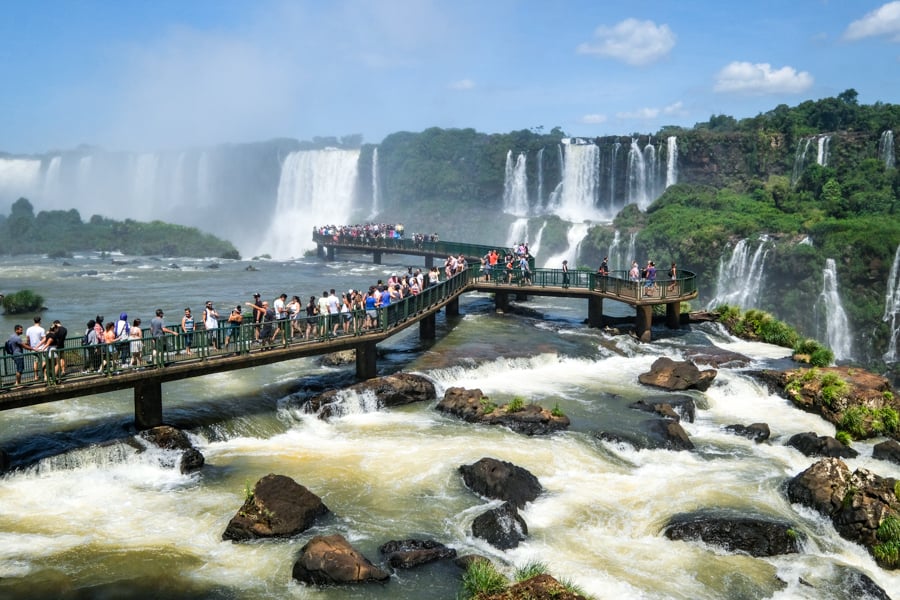
Iguazu Falls Brazil side
• Opening Hours (Brazil)
The opening hours for the Brazil side are 9 AM to 6 PM every day of the year, but the last entry is at 4:30 PM.
• Map (Brazil)
Here’s a map of the Iguazu Falls Brazil side to help you navigate the waterfall area. You can click the map to view it in full size.
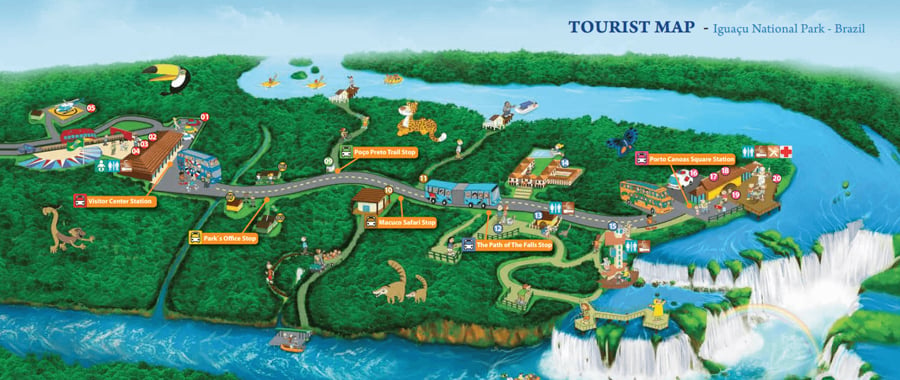
Map of Iguazu Falls Brazil side (© Parque Nacional Do Iguacu)
How Much Time To Spend At Iguazu Falls
You need two full days to really see and explore both sides of Iguazu Falls: one day for Argentina, and one day for Brazil. The Brazil side can be done in a half day if you skip the bird park.
A third day at Iguazu will give you more flexibility with weather, and it’ll allow you to re-visit one of the national parks or else do a day trip to Paraguay to see Monday Falls (the Saltos Del Monday waterfall).
If you’re really pressed for time, it’s possible to see both sides of Iguazu Falls in a single day (Argentina and Brazil), although you’ll have to use a tour in order to speed up the border crossings and other logistics.
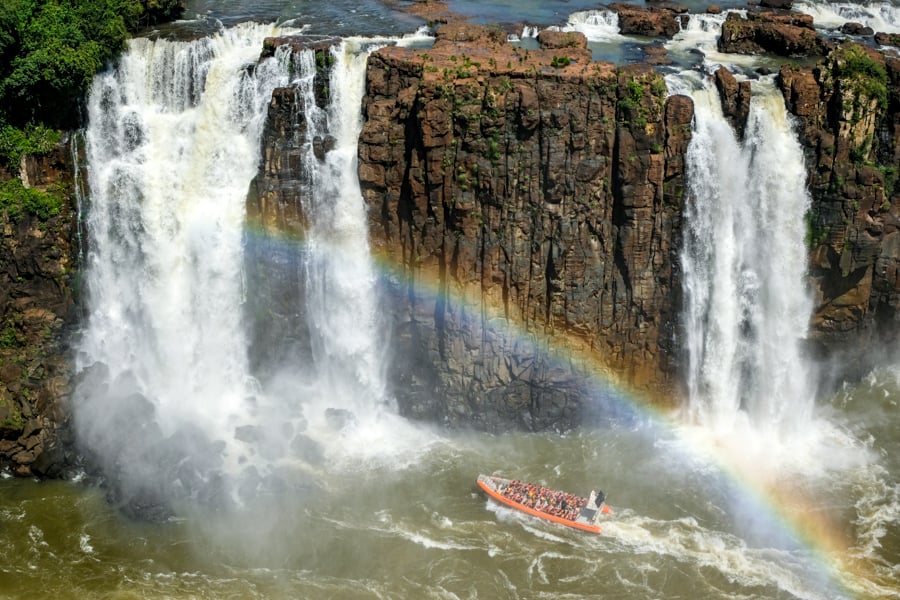
Boat cruise in a rainbow
What To Bring To Iguazu Falls
- Clothing: The climate at Iguazu is tropical, so it’s hot and humid year round. You’ll want to dress for summer. Shorts and sandals are a good idea.
- Sunscreen: It can be very hot and sunny here, so you’ll want a hat and sunscreen. This is the only place I got any burn in Argentina.
- Rain Coat: There can be extreme mist and spray at some areas of the waterfall, such as the Devil’s Throat, so a poncho is helpful to keep you dry.
- Bug Spray: In general there aren’t many mosquitoes at Iguazu, and I think they’re mostly scared away by the noise and spray of the waterfalls. However, some areas of the park are more calm and you’re likely to run into mosquitoes and other bugs there, so bring bug spray just in case.
- Vaccines: I got the Yellow Fever vaccine before traveling here, and I think it’s a good idea, especially if you plan to travel to Yellow Fever areas in the future. The vaccine is good for life. According to the US CDC, there is some presence of Yellow Fever in the mosquitoes around Iguazu. The vaccine is recommended, but not required by Argentina or Brazil, so that’s your decision to make. Most people don’t bother with the vaccine, and have a great trip anyways.
- Camera: Both sides of the waterfall are very photogenic. A lens with a little bit of zoom is best, although for the Devil’s Throat you’ll want a wide angle lens.
- Passport: If you’re crossing a border, remember to bring your passport. You’ll need it, and it’s easy to forget. Aside from border crossings, however, you won’t need to carry your passport everywhere. For example, if you’re staying in Argentina you won’t need to bring your passport to visit the Argentine side of the falls. It’s not required for entering either of the national parks (just crossing the border), and it would be bad to get your passport wet!
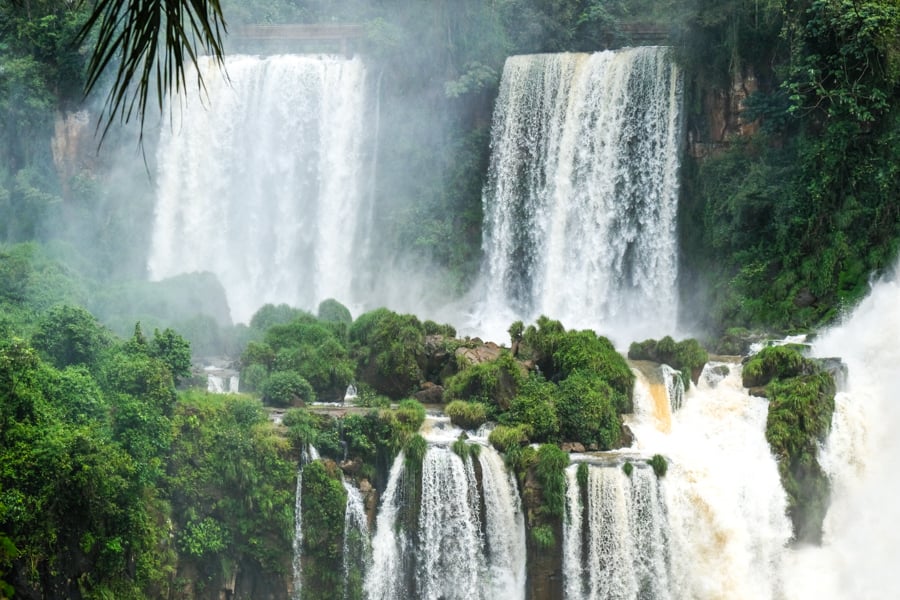
Iguazu Falls Argentina side
Best Time To Visit Iguazu Falls
There’s really no best time to visit Iguazu Falls. It has a good flow all year long, and it’s always photogenic!
If you want cooler weather, the humidity and temperatures are best from May to August. These are also some of the least rainy months of the year, and the bright sunny days are great for seeing rainbows at the falls.
With that said, I’ve visited Iguazu in the wet season and there really wasn’t too much rain at all. It was mostly sunny every day, with one shower in the evening, and the rain didn’t affect any of my plans.
Naturally, the waterfalls have the strongest and most impressive flow during the rainy season, although sometimes the water can look a bit brown and muddy, which may not be ideal for photos (I’m nitpicking there).
The best time of day to visit Iguazu Falls is in the morning so you can avoid some of the heat and crowds. This is a very popular tourist destination, so it gets pretty crowded by noon. Photography is good at any time of day, though.
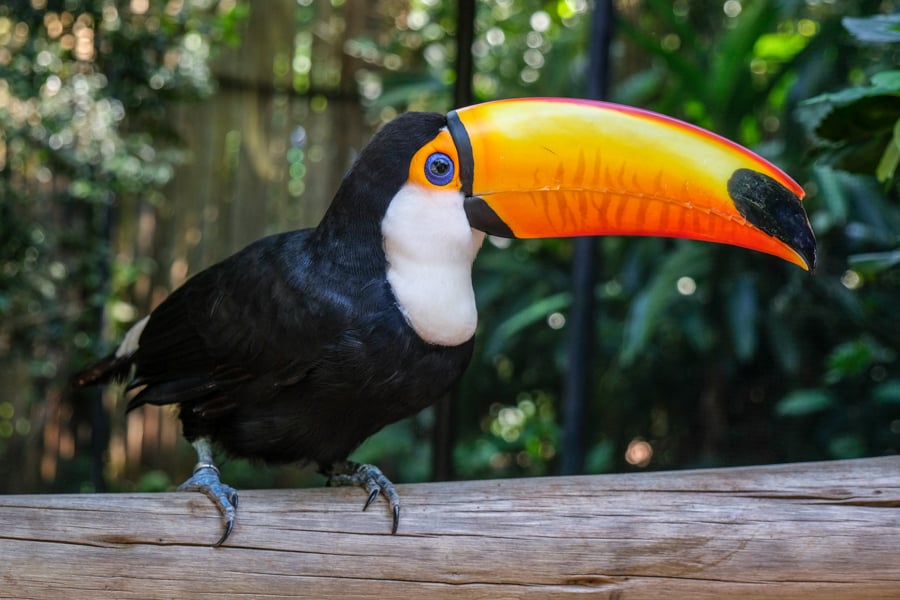
You can see macaws and toucans at the Brazil bird park near Iguazu
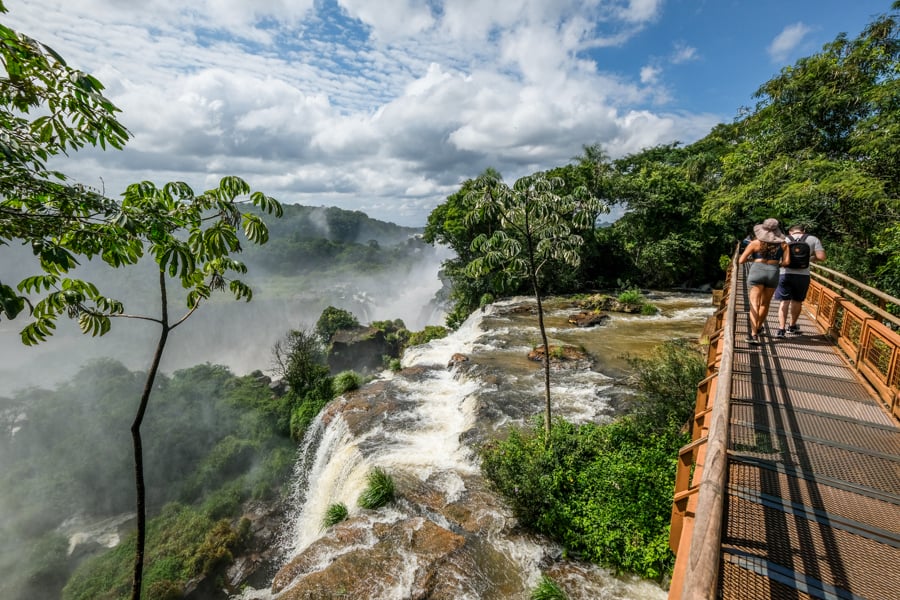
The walkways in Argentina give you some great views
Iguazu Falls Argentina vs Brazil: Which Side Is Better?
So which side of Iguazu Falls is better? The Argentina side, or the Brazil side? That’s a tough question, because both sides are amazing.
The main advantage of the Argentina side is that it’s bigger and has more trails and walkways to explore. The Devil’s Throat viewpoint is also arguably the most spectacular thing you can see at Iguazu.
The Brazil side, on the other hand, is more compact but it still has some unique scenery and walkways. I would even argue it’s more photogenic than the Argentina side. Plus there’s a nice bird park near the entrance!
In conclusion, I thought the Argentina side was a bit more impressive to see with my own eyes, but the Brazil side may be better for taking photos. Both sides are very worthwhile, and I would recommend seeing both if you’re able.
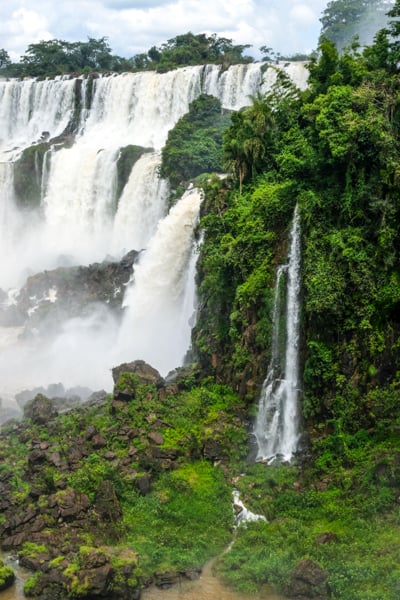
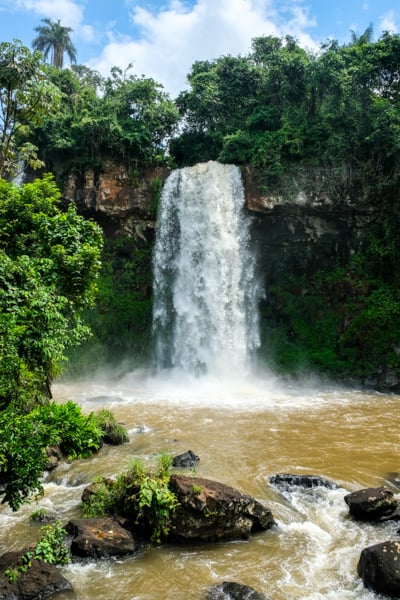
Iguazu Falls Paraguay Side: Saltos Del Monday
If you want to see another big and beautiful waterfall near Iguazu Falls, there’s a nice one in neighboring Paraguay called Monday Falls (‘Saltos Del Monday’).
Technically this waterfall is not part of the same river system as Iguazu Falls, and it can’t compare in size or greatness, but it’s located nearby and the cascade is a pretty impressive one in its own right, with a height of more than 45 meters (150 feet).
It’s easy to visit Paraguay and the Monday Falls on a day trip from either the Argentina or Brazil side of Iguazu Falls, and as a bonus, you also get to check off another country (Paraguay) from your bucket list!
Read More: Saltos Del Monday Paraguay
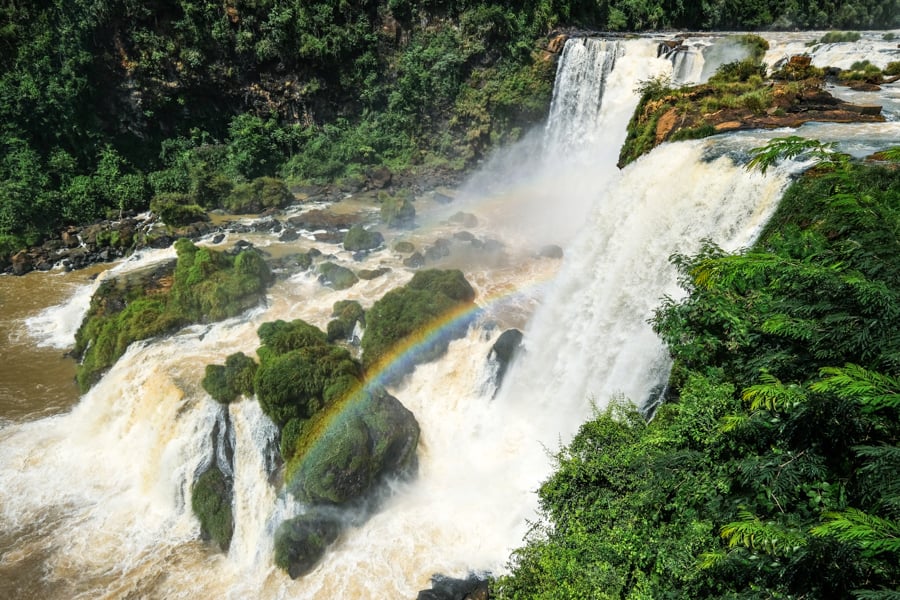
Saltos Del Monday is a nice waterfall in Paraguay that you can visit on a day trip.
Fun Facts About Iguazu Falls
- How big is it?
Iguazu Falls is huge. It’s actually the largest broken waterfall system in the world, with 275 individual cascades. Iguazu has a height of 64 to 82 meters (210 to 269 feet), a width of 2,700 meters (8,858 feet), and a mean annual flow rate of 1,746 cubic meters per second (61,600 cubic feet per second).
- How does it compare to Niagara Falls in Canada and USA?
Iguazu Falls is frequently compared to Niagara Falls in North America, which sits on the border between Canada and the United States. Iguazu is bigger than Niagara in most ways. It’s higher and much wider, although Niagara has a stronger flow rate.
- How does it compare to Victoria Falls in Zambia and Zimbabwe?
Iguazu Falls is also often compared to Victoria Falls, which is a waterfall in Africa on the border between Zambia and Zimbabwe. Victoria Falls is the biggest curtain of water in the world, and it’s also taller than Iguazu. Collectively, Iguazu is wider than Victoria, but it’s split into roughly 275 distinct waterfalls.
- What is the source?
The Iguazu River is the source of the waterfall, and it originates in the Serra do Mar mountains of Brazil. This river is about 1,320 kilometers (820 miles) long.
- How did it get its name?
The name Iguazu comes from indigenous Guarani words meaning ‘great water.’ It’s pronounced ‘ee-wasu’ or ‘ee-wazu’ although many people also pronounce it ‘eeg-wazu’ or ‘ig-wazu.’
- Is it a national park?
Yes, Iguazu is a national park in both Argentina and Brazil. Each side is considered a separate national park. The Argentina side is officially called Parque Nacional Iguazú in Spanish, while the Brazilian side is called Parque Nacional Do Iguaçu in Portuguese.
- What is the UNESCO status?
The Iguazu National Park in Argentina has been recognized as a UNESCO World Heritage Site since 1984, and the Brazil side has also been separately recognized by UNESCO since 1986. This is because of the area’s outstanding natural significance and beauty, as well as the biological diversity.
- Can you stay inside the national park?
Yes, the Argentina national park has the Gran Melia Iguazu, while the Brazil side has the Belmond Hotel Das Cataratas. These hotels are expensive but high rated, and they’re the only options if you want to stay directly inside the national park and be right at the falls.
- What other facilities are there?
Both national parks have lockers for storing luggage, and they also have plenty of bathrooms, cafes, maps, and souvenir shops. The parks have ATMs, but they’re not reliable for drawing cash. Thankfully you can pay for everything in the park with a credit card, and it’s possible to get cash from the banks in town.
- How hard is it to get to Iguazu Falls?
It’s easy to get to either side of Iguazu Falls. You can fly into the town on either side of the river and use it as a base to see both Argentina and Brazil using a bus, taxi, or tour.
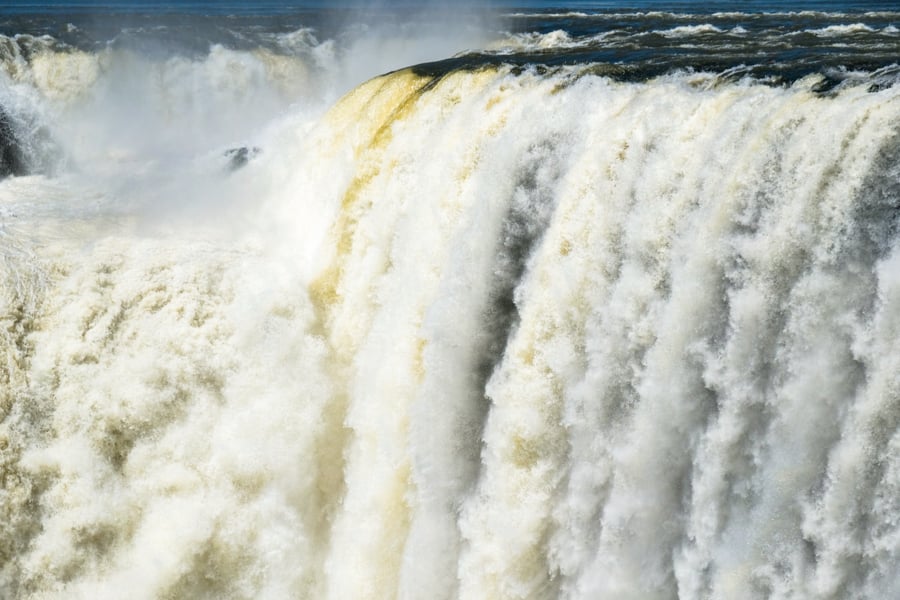
The roaring Devil’s Throat
Other Tips For Puerto Iguazu / Foz do Iguacu Town
- Hotels: There are a bunch of comfortable hotels and hostels in Puerto Iguazu town (Argentina), and also in Foz do Iguacu town on the Brazilian side.
- Restaurants: You can find lots of nice cafes and restaurants on both sides of Iguazu, so you’ll never have a hard time finding somewhere to eat breakfast, lunch, or dinner.
- Cash: You can withdraw cash at one of the bank ATMs in town. Sending money to yourself via Western Union is another option.
- Credit Cards: Most places in town accept credit cards, but some smaller places may be cash only. Keep some cash just in case.
- WiFi: The hotels and restaurants in town usually have fast, reliable WiFi. I was able to find great WiFi everywhere I went.
- Cell Service: There is good cell service/phone reception in town on both sides of the falls, although you may lose signal at times when touring the Iguazu waterfall because it’s pretty spread out.
- Safety: The Iguazu area is safe for tourists, and generally you don’t have to worry about crime in town. Just practice normal precautions. Don’t leave cash in your room, or valuables in your car.
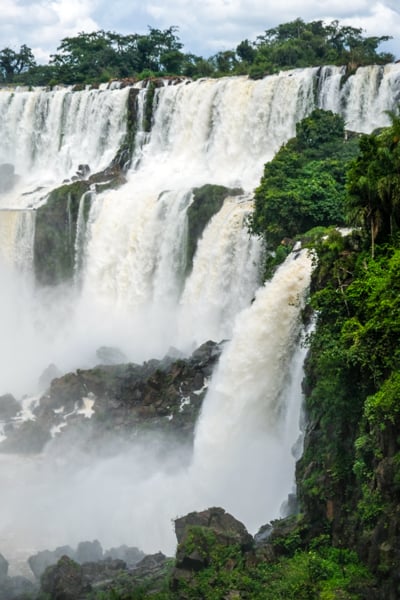
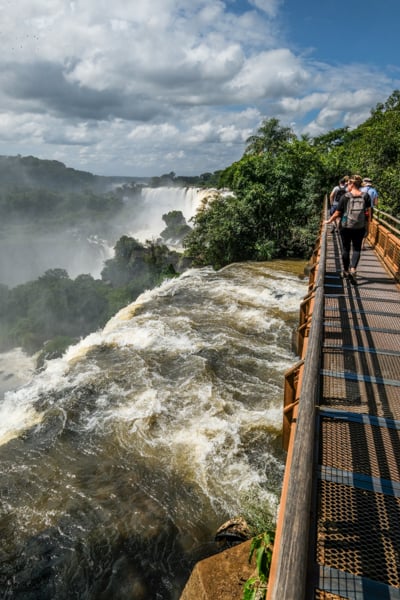
Is Iguazu Falls Worth It?
Yes, Iguazu Falls is absolutely worth it!
Even though it’s not the easiest place to visit in Argentina or Brazil, this waterfall really deserves the detour. It’s one of the biggest and most impressive falls in the world.
If you’re planning to travel through South America, definitely add this place to your bucket list!
Is Iguazu Falls Open / Closed Right Now?
Yes, Iguazu Falls is currently open to tourists in both Argentina and Brazil! Both parks are wide open to international tourists. I’ll update this travel guide if anything changes.
Some areas of the park may be closed from time to time for maintenance, but this is temporary and they usually reopen quickly. You can also check current updates on the official websites for Iguazu Argentina and Iguazu Brazil.
Happy travels!
More South America Travel Tips
Thanks for looking! I hope you enjoyed this map and travel guide for Iguazu Falls Argentina and Brazil.
I have a bunch of other travel blog posts for Argentina and South America, so don’t forget to check them before you go.